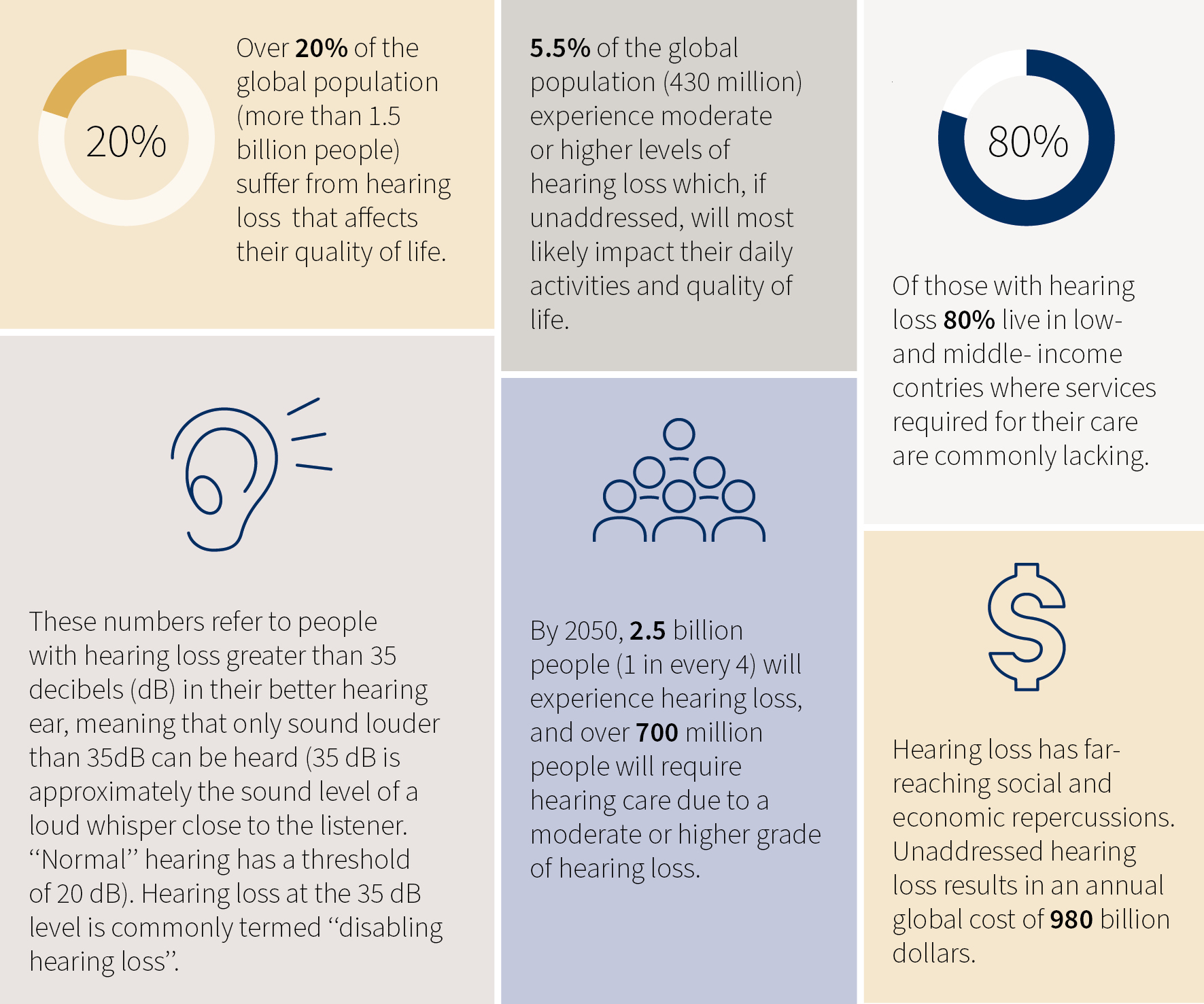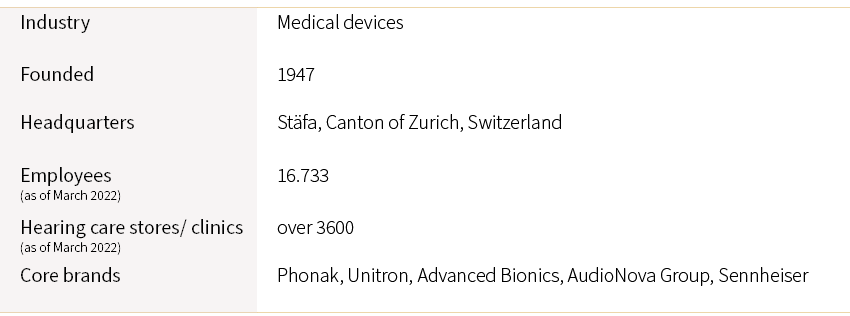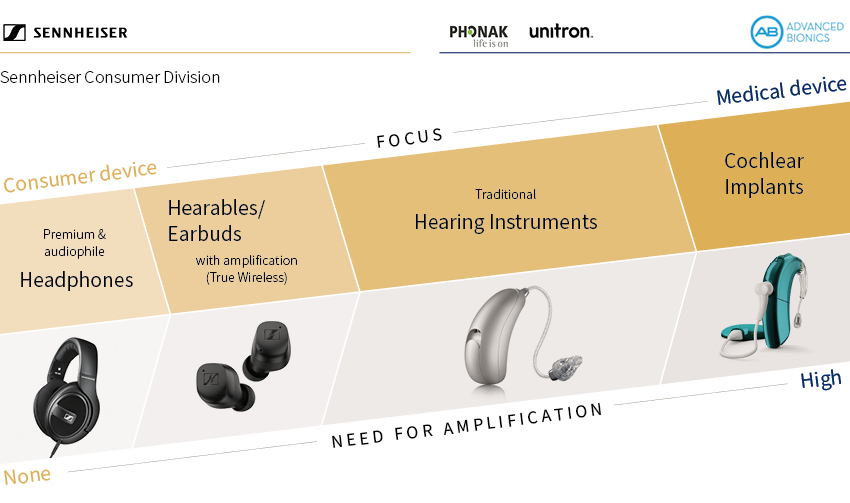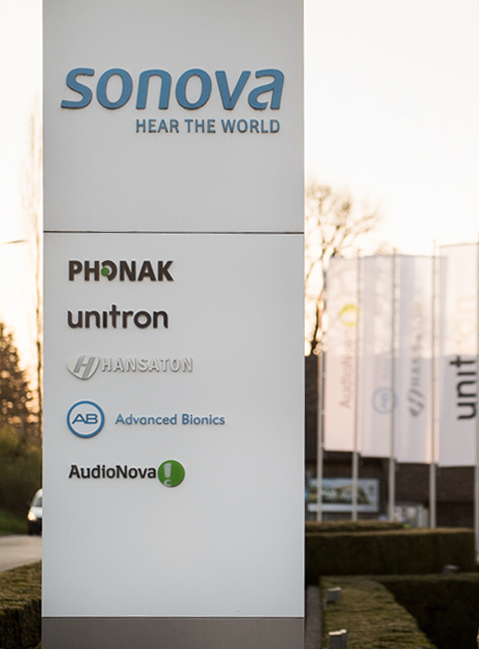Company Insights: The sound of Sonova
15/09/2022
Hearing loss is a worldwide issue. However, the importance of good hearing and the consequences of hearing loss continue to be underestimated even though the World Health Organization (WHO) estimates that hearing loss currently affects more than 1.5 billion people (20% of the global population).
430 million people (5.5% of the global population) experience moderate or higher levels of hearing loss which, if unaddressed, will most likely impact their daily activities and quality of life.1 The WHO estimates that by 2050, 2.5 billion people (1 in every 4) will experience hearing loss, and over 700 million people will require hearing care due to a moderate or higher grade of hearing loss.2 At the same time, unlike reading glasses, which award the wearer a certain distinction and intelligence, there still exists a strange stigma around the wearing of a hearing aid, of which Sonova is one of the largest providers worldwide.
[1] WHO, "World Report on Hearing" (2021): Page 40
[2] WHO, "World Report on Hearing" (2021): Page 139
Chart 1: Overview hearing loss worldwide Source: WHO, "World Report on Hearing" (2021).
Source: WHO, "World Report on Hearing" (2021).
We interviewed Sonova's CEO Arnd Kaldowski about the company's clients, the firm's product portfolio and the general market outlook.
At Rothschild & Co Wealth Management Switzerland (Rothschild & Co Bank AG), we are long-term investors in Sonova and have gained a deep understanding of the business and the market in which it operates. For more information, please contact your Client Adviser.
|
Sonova Holding AG is operating in the healthcare sector. The company, along with its subsidiaries, designs, develops, manufactures, distributes and services hearing systems for adults and children with hearing impairment. It is active in two operating segments: The hearing instruments segment, that includes the companies that work in the development, production and distribution of hearing instruments, personal audio devices as well as related products, Sonova sells its products in over 90 countries through its own distribution network and through independent distributors. |
Chart 2: Sonova key facts and figure
Q1. For our readers, Arnd, what does your average client look like and can you outline the attractiveness of the Hearing Aid industry?
Our average Sonova client is between 70 and 71 years old, the age of first-time hearing aid users is probably 4 to 5 years lower. It is an interesting time to be in the hearing instruments business: long-term market growth has accelerated as the baby-boomer generation arrives at the age when hearing loss becomes common. This generation has a higher digital affinity and is extremely active, which means that a device that is easy to wear and connectable to all sorts of communication devices is required. What makes the market attractive for investors? First, its strong fundamentals since the average client these days has significantly more money available and is getting older. And second, the product perspective: Hearing aids have improved significantly and the combination of better hearing performance as well as new functionality gives us a lot of runway from a technology innovation perspective to generate better outcome.
Q2. A common statistic says that eight out of ten people who need hearing aids don’t use one. What are the key reasons for this lack of uptake and how are you addressing them?
The lack of uptake and reasons for it depend on the geography. Especially in developing countries people are not aware how good our devices have become. Moreover, there is a general misconception when it comes to their size and quality. This is not so much the case in developed countries. Another factor is affordability and the reimbursement environment. Our customers are mainly older people who draw a fixed or retirement pension. In Europe, they usually receive government or insurance subsidies for the purchase of hearing aids, in the US this is not always the case and in many South Asian countries, Asian Pacific and Sub-Saharan African regions hardly ever. Furthermore, wearing a hearing aid is still stigmatized, especially in Asia, where it is culturally harder to show limitations.
When it comes to addressing these issues, we continuously try to build awareness via our own hearing care stores and work with hearing care professionals where we act as B2B players. We also collaborate with the insurance sector to establish coverage models, conduct clinical studies to prove medical evidence and have adopted a "one time" financing model that includes 5 years of free service upon buying a device in our own retail hearing care stores. To contradict the assumption that hearing aids are noticeable and make people less attractive, we have designed smaller devices and tried to combine hearing aids with hearables. With this in mind, we developed e.g., the Phonak Marvel In-The-Ear hearing aid. Originally, we produced it in skin colour only but now also offer it in black so people can no longer clearly distinguish between a hearing aid and an earbud.
Q3. Sonova has recently acquired the Consumer Division from Sennheiser, thereby getting exposure to the Consumer Hearing business. Can you provide us with some more background and why are you so excited about this business?
Sennheiser has a very strong business in premium headphones and audiophiles which we liked. The actual strategic aim however was the speech-enhanced hearable segment. We interviewed lots of our customers and it turned out that those who purchase earbuds are looking for speech-enhanced functionalities in their earbuds. Sonova has the technologies for it but we realized that we were missing the direct access to the consumer channels. Sennheiser is going to bridge the gap between us and the consumers, access an in-between segment and bring people who are not yet ready for hearing aids 3 to 4 years earlier to the category.
Chart 3: Consumer hearing journey
Q4. Sonova has expanded its portfolio and today operates over 3,600 hearing care stores globally. Given the general shift of shopping habits towards online, can you envision a world, in which a Sonova customer has all the technical capabilities to make a fitting entirely from home?
We have been following the discussion on online sales and self-fitting for many years. Interestingly enough, even during the whole Covid phase, we couldn’t convince our clients to do the 2nd or 3rd fitting online. What are the reasons? For consumers, this is a medical profession which means, that they want to get the diagnosis on their hearing capabilities as well as their treatment (fitting) done by a professional. Therefore, the majority prefers to go to a physical store and see their trusted advisor. I think that in 10 years' time we will still have many physical stores with the percentage of people who do at least part of the fitting online slightly higher.

View from the Analysts
Having been invested in Sonova from 2014 to 2017 and again since February 2022 in our Mosaique strategies and since 2016 in our LongRun strategy, we consider the company well positioned to outgrow the underlying market on the back of recent product launches.
The company benefits from these new products, which are well received in the market, and from the balance of its three main distribution channels (wholesale, retail and online). On a longer-term basis, we continue to believe that Sonova is the best positioned company in what is a very attractive industry with secular demographic tailwinds, a consolidated market structure and attractive economics.
Q5. Can you provide us with some background on the most recent technological evolutions at Sonova and have there been any recent technology updates or product releases that stood out for you?
The topic of rechargeability was a big move some 5 years ago. It brings peace of mind and ultimately leads to better reliability because you don’t need to open the device to charge it. At the same time, elderly people often struggle with their fingers, so it is more user friendly. Another milestone was when we moved to connectivity. Our competitors purely concentrated on connectivity to iPhones. We took a different route and developed a connectivity chip that is so low on energy consumption that you can connect it via Bluetooth. 4 years in, we are still a leader in that field and our devices are the only ones which can connect well to Android phones and tablets. This had a very positive impact during Covid when people moved to working from home and could easily connect their different electronical devices to their hearing aid. Another exciting development is that we are currently in the process of bringing sensors into our hearing aids. One example is our so-called "accelerometer" which can detect movement as well a heart rate sensor which can measure the pulse. An interesting effect of the accelerometer is that - paired with an algorithm - it enables the hearing aid to detect movement when you walk next to a person and adjust the sound processing accordingly. This is an example of how technology advances and allows you to do things you were not able to do before.
Q6. Turning to the future: What do you expect the hearing aid market to look like in 10 years and how do you expect this to translate into growth opportunities for Sonova?
One big opportunity is clearly in high growth developing markets. One example is China where we are always shocked how few people use hearing aids. In the Western world around 25% to 30% of people with hearing loss use hearing aids, in China it is 2% to 3%. What is holding them back? There are various reasons: Affordability, stigma, awareness issues as well as the lack of availability of hearing care professionals. From a geo-perspective, our industry has not seen the same growth as other medical devices. In the field of diagnostics or life- science for example, China tends to be 20% of the book of business, in "our world" it is 3%. So, there is some work to be done in China. We also want to bring people to use hearing aids earlier. It takes our average customer around seven years from the time he/ she is diagnosed with hearing loss to decide on a hearing aid, because many don't want to admit to hearing loss for a long time. It is going to result in significant growth, if we are able to move that forward by 2 to 3 years. The last one is incremental functionality: Medical studies have proven that someone with untreated hearing loss falls three times as often and dementia as well as depression progress three times faster. This is an area with a huge health economics need since these are expensive diseases from a "care taking over lifetime perspective" and also impacts the quality of life. I have the vision that in 10 years, a hearing aid device is a healthy living companion with more functionality. To get us there Sonova progressed the connectivity to android as mentioned earlier and is ahead of others on sensor technology.
|
Arnd Kaldowski, CEO at Sonova, was interviewed on June 28th, 2022 by our Investment Insights and Equity Analyst teams at Rothschild & Co Bank AG. The views expressed in this interview are from Sonova and are not made on behalf of Rothschild & Co Bank AG. |